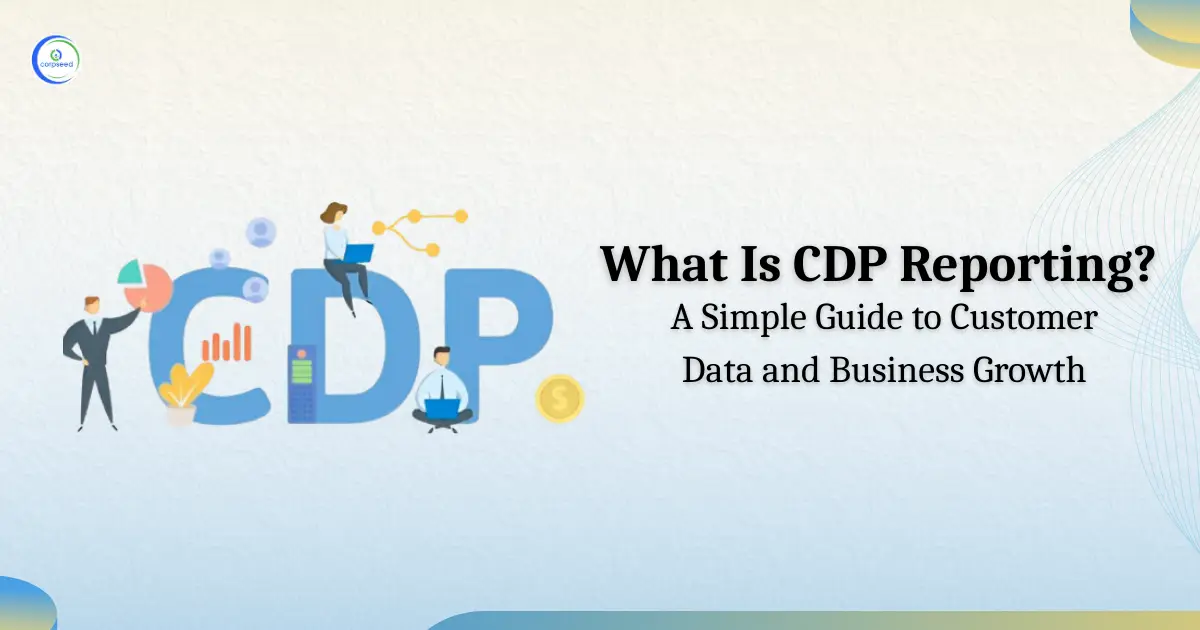In today’s world, transparency around environmental impact is more significant than ever. The Carbon Disclosure Project (CDP) is a global platform that promotes companies to measure, disclose and regulate their environmental impact. CDP reporting includes capturing and sharing important data related to carbon emissions, water use, deforestation, and climate-related risks. This transparency helps businesses enhance sustainability, fulfill regulatory requirements, engage stakeholders and create long-term resilience.
Table of Contents
What Is CDP Reporting?
CDP reporting is the process by which organizations submit detailed disclosures about their environmental performance and climate-related risks through the framework of the Carbon Disclosure Project. These reports usually involve data related to greenhouse gas emissions, energy consumption, water management, and supply chain impacts. Its purpose is to offer investors, regulators, consumers and other stakeholders with standardized, comparable and reliable information on how companies are addressing the challenges of climate change and sustainability.
Unlike traditional sustainability reporting, CDP reporting underlines measurable data linked to global climate frameworks such as the Task Force on Climate Related Financial Disclosures (TCFD). This allows companies to not only demonstrate progress but also identify risks and opportunities related to climate changes.
--------------Blog Contact Form-------------
Why CDP Reporting Matters
Implementing CDP reporting offers numerous key benefits:
- Enhance Transparency and Accountability: CDP reporting provides clear insight into environmental impacts, helping companies show their commitment to sustainability and build trust with investors, customers, and regulators.
- Identify and Manage Climate Risks: Revealing climate-related risks allows businesses to better understand vulnerabilities in their operations and supply chains, facilitating more resilient strategies.
- Drive Environmental Performance Improvements: Tracking emissions and resource use promotes companies to set reduction targets, advance efficiency, and minimize costs.
- Align with Investor and Regulatory Expectations: Many investors and governments progressively need climate disclosures, making CDP reporting vital for compliance and access to capital.
- Improve Reputation and Stakeholder Engagement: Transparency promotes resilient relationships with stakeholders who prioritize sustainability and corporate responsibility.
Key Metrics Tracked in CDP Reporting
To provide meaningful insights, CDP reports commonly comprise:
- Greenhouse Gas (GHG) Emissions: Scope 1 (direct), Scope 2 (indirect from energy), and Scope 3 (value chain emissions)
- Energy Consumption: Total energy used, renewable energy share
- Water Usage and Management: Total withdrawal, recycling, and risks related to water scarcity
- Climate Risks and Opportunities: Identification and management of physical and transitional climate risks
- Deforestation and Land Use Impacts: Monitoring impacts across supply chains
- Emissions Reduction Targets: Commitments and progress toward climate goals
Best Practices for Effective CDP Reporting
To maximize the value of CDP reporting, companies should:
- Collect Accurate, Verified Data: Ensure high-quality data through strong measurement systems and third-party verification when possible.
- Engage Cross-Functional Teams: Include departments such as sustainability, finance, operations, and supply chain for complete data collection and risk assessment.
- Align with Global Standards: Follow frameworks like TCFD and GHG Protocol to enhance credibility and comparability.
- Use Transparent and Clear Communication: Present data in a clear, accessible way to build stakeholder confidence.
- Leverage Technology for Data Management: Utilize software solutions to simplify data collection, reporting, and analysis.
How to Choose the Right Approach for CDP Reporting
When preparing for CDP reporting, consider:
- Data Collection Capabilities: Systems in place to gather reliable environmental data from across operations and supply chains
- Expertise and Resources: Access to sustainability professionals or consultants experienced in CDP requirements
- Integration with Corporate Strategy: How environmental data ties into broader business goals and risk management
- Stakeholder Needs: Understanding the expectations of investors, regulators, and customers
- Commitment to Continuous Improvement: Using CDP reporting as a tool for ongoing sustainability performance enhancement.
Conclusion
CDP reporting is an important source for those organizations aiming to navigate the complexities of climate change and sustainability. By transparently disclosing environmental data and risks, companies can not only meet regulatory and investor requirements but also drive meaningful enhancements in environmental performance and resilience. As global pressure for climate action intensifies, businesses that prioritize CDP reporting will be better positioned to safeguard their operations, create value, and lead in the transition to a sustainable future.
FAQ`s
CDP is a global non-profit that collects environmental data from companies to promote transparency on climate change, water, and deforestation.
No, it's voluntary but often requested by investors and customers, and increasingly expected for ESG transparency.
CDP focuses on environmental data, while ESG reporting covers environmental, social, and governance topics more broadly.
Investors, regulators, and stakeholders use CDP data to evaluate environmental risks and sustainability performance.
By enhancing data quality, setting emissions targets, managing climate risks, and aligning with global standards like TCFD.
This portion of the site is for informational purposes only. The content is not legal advice. The statements and opinions are the expression of author, not corpseed, and have not been evaluated by corpseed for accuracy, completeness, or changes in the law.
BOOK A FREE CONSULTATION
Get help from an experienced legal adviser. Schedule your consultation at a time that works for you and it's absolutely FREE.



.webp)





